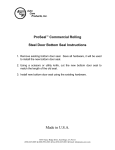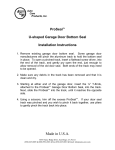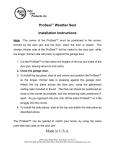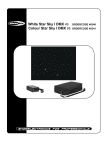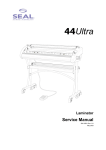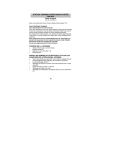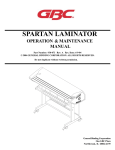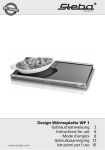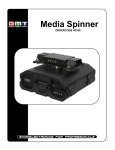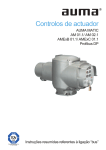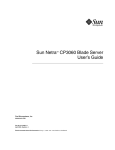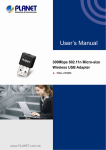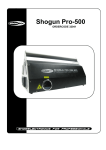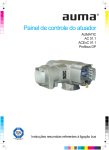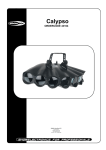Download 25" ProSeal
Transcript
Technical Service Manual 11 Front Matter TM TM ProSeal 25 / ProSeal 44 Technical Service Manual REV 2.0 Revision History Amendments will be listed on this page, including their descriptions and dates. REV Date 1.0 Nov 1999 2.0 Feb 2000 i Description Original version (pre-release). Released version; the manual covers US as well as EU machines. Page numbering starts with each section. Changed pages: all. The pressure- and nip setting procedures have been changed in accordance with the new roller setup (uncrowned top roll, crowned bottom roll). i February 2000 Front Matter Safety Statements TM The ProSeal laminators have been designed with operator safety as a primary objective; however, operators must be familiar with the controls, as well as the operation before using the unit. The electrical and drive-system components are isolated from contact with the operator by enclosing them within plastic end covers that are bolted on. Only qualified service technicians should remove these protective covers after power to the machine is removed including disconnecting the power cord. The heated top roller can reach temperatures of 160C (320°F). For operator safety, a protective heatshield is mounted over the top roller, and attached to the top aluminum extrusion. Adequate ventilation is guaranteed; because of this, the outside temperature of the extrusion will never exceed 45°C (113°F). Only qualified service technicians should remove the top extrusion in order to clean the rollers if necessary. Safety Features The material inlet opening has a height that is in accordance with EN294 clause 4.5.2; the IEC1032 test finger cannot enter this opening. The heating system is provided with an over-temperature device, which will shut off the top rollerheating element once a heating system failure occurs. Caution Everyone working around the laminator must avoid wearing loose fitting clothing (ties!) or dangling jewelry, which could catch in the laminator rollers. Technical Service hazards Fire hazard – The laminator contains a heated roller which reaches temperatures of 160°C (320° F). There is a danger of severe burns if the heated roller is touched during servicing. Mechanical hazard – Failure to use caution near exposed rollers could result in physical injury. fig. 1 ii ii February 2000 Front Matter Note: When performing procedures that require the side covers to be opened, ensure that the power cable is disconnected from the mains. Several parts, like the mains switch (1) and the overtemperature switch (2), could cause electrical shock if the power is not disconnected! 1 2 fig. 2 iii fig. 3 iii February 2000 Table of Contents Section 1. 1-1. 1-2. Section 2. 2-1. 2-2. Section 3. 3-1. 3-2. Section 4. 4-1. 4-2. 4-3. 4-4. 4-5. 4-6. 4-7. Section 5. 5-1. 5-2. 5-3. Section 6. 6-1. 6-2. 6-3. Section 7. 7-1. Section 8. 8-1. 8-2. 8-3. iv Machine Characteristics Machine Description........................................................................................1-1 Machine Specifications ....................................................................................1-1 Installation Preinstallation.................................................................................................2-1 2-1-1. Electrical Requirements ................................................................2-1 2-1-2. Workspace Requirements.............................................................2-2 Setup .............................................................................................................2-2 Theory of Operation Control Knob...................................................................................................3-1 Control Panel..................................................................................................3-2 Disassembly / Reassembly Procedures Opening / Closing the Aluminium Top Cover .....................................................4-1 Feed-in Table..................................................................................................4-2 Plastic Side Covers .........................................................................................4-2 Heating Element .............................................................................................4-4 Software.........................................................................................................4-6 Rear Panel .....................................................................................................4-7 Solid State Relay ...........................................................................................4-8 Adjustment Procedures Laminating Pressure Adjustment ......................................................................5-1 Nip Adjustment ...............................................................................................5-2 Temperature Adjustment .................................................................................5-6 Maintenance Cleaning of the Machine..................................................................................6-1 Regular Cleaning of the Rollers by the Operator................................................6-1 Cleaning of the Rollers by Service Technicians .................................................6-1 Troubleshooting Troubleshooting..............................................................................................7-1 Diagrams Electrical Schematics ......................................................................................8-1 8-1-1. Schematic Installation Diagram ProSeal 25 – 110V/60Hz................8-1 8-1-2. Schematic Installation Diagram ProSeal 44 – 110V/60Hz................8-2 8-1-3. Schematic Diagram Control PCB 110V 50/60Hz.............................8-3 8-1-4. Schematic Diagram Controlpanel ..................................................8-4 8-1-5. Schematic Installation Diagram ProSeal 25 – 230V/50Hz................8-5 8-1-6. Schematic Installation Diagram ProSeal 44 – 230V/50Hz................8-6 8-1-7. Schematic Diagram Control PCB 230V 50/60Hz.............................8-7 Certified Electrical Components Lists & Spare Part Codes .................................8-8 8-2-1. 110VAC/60Hz Machines ...............................................................8-8 8-2-2. 230VAC/50Hz Machines ...............................................................8-9 Mechanical Spare Parts List, Assembly Drawings & Exploded Views................8-10 8-3-1. Mechanical Spare Parts List........................................................8-10 8-3-2. Assembly Drawings & Exploded Views ........................................8-11 iv December 1999 Machine Characteristics Section 1. 1-1. Machine Characteristics Machine Description TM TM The ProSeal 25 and ProSeal 44 laminators are electro-mechanical devices containing two silicone rollers, a heating element for the top roller, an electronic PIZ controller for a fixed temperature, and a synchronous drive AC motor to maintain a constant process speed. The ProSeal laminators have been designed to be used with ProSeal Pouch Boards and ProSeal Flexible Pouches. When used with these products, one is able to mount, mount and laminate, and encapsulate prints in one step. Each machine is provided with a User Manual; the purpose of this manual is to outline the materials and processes when using ProSeal supplies using this laminator, to create signs, displays, and flexible graphics with professional results. The manual includes instructions of various laminating procedures, which are meant to give the user comprehensive information needed for the efficient use of his laminator. TM TM TM TM These machines have not been tested with any other materials and are not recommended for use with products other than ProSeal supplies. TM TM The US versions of the ProSeal machines are provided with fixed powercables and NEMA plugs; the European versions are provided with Euro appliance inlets (see also Section 8). TM The ProSeal laminators meet the Machinery Directive (89/392/EEC & applicable amendments). They rd are ETL and cETL listed per directive UL 1950 3 Edition 1995 and CAN/CSA C22.2 No. 950-95. 1-2. Machine Specifications TM TM ProSeal 25 ProSeal 44 Mechanical Height Overall Width Depth Net Weight Shipping Weight 12” (305 mm) 40” (1016 mm) 15” (380 mm) 77 lbs. (35 kg) 90 lbs. (41 kg) 12” (305 mm) 58” (1473 mm) 15” (380 mm) 154 lbs. (70 kg) 172 lbs. (78 kg) Electrical US version EU version 110VAC/60Hz 12A 230VAC/50Hz 7A 110VAC/60Hz 16A 230VAC/50Hz 9A 25” maximum (635 mm) 1 N/mm 1’/min (305 mm/min) 311-320°F (155-160°C) 0 (closed nip) 1/16” (1.5 mm) 1/8” (3 mm) 3/16” (5 mm) ¼” (6 mm) 44” maximum (1120 mm) 0.8 N/mm 1’/min (305 mm/min) 311-320°F (155-160°C) 0 (closed nip) 1/16” (1.5 mm) 1/8” (3 mm) 3/16” (5 mm) ¼” (6 mm) 60766 60794 60824 60853 Process Working width Roller Line Pressure Process speed Process temperature Nip Settings Order Codes US version EU version 1 1-1 February 2000 Installation Section 2. 2-1. Installation Preinstallation The following requirements are applicable: 2-1-1. Electrical Requirements This unit should only be connected to a power supply outlet of the voltage, amperage, and frequency marked on the rear panel. The laminator has a grounded plug (three prongs). To reduce the risk of electrical shock, this plug is intended to fit only a grounded outlet of the proper amperage, and in only one way. The US versions of the ProSeal machines are provided with fixed powercables and NEMA plugs; the European versions are provided with Euro appliance inlets (see also Section 8). TM The electrical specifications of the machines are: ProSeal 25 110VAC/60Hz 12A 230VAC/50Hz 7A US version EU version ProSeal 44 110VAC/60Hz 16A 230VAC/50Hz 9A The ProSeal machines must be installed next to the power outlet; extension cords are not to be used. The plug and the outlet must be easily accessible by the operator. For the US versions, there are two types of outlets (receptacles), shown below. G L G N NEMA 5-15R Using 15 Amp Breaker ProSeal 25 L N NEMA 5-20R Using 20 Amp Breaker ProSeal 44 Note: T-slot is not applicable for Canada For both EU versions, in the UK, the following is applicable: BS 1363 – 13A wall receptacle: Use the provided BS 1363 plug For both EU versions, mainland Europe, the following is applicable: French Belgium German, Netherlands Portugal, Spain Use the provided Schuko plug (10A). 1 2-1 February 2000 Installation Wirecolours: General (EU) Blue Yellow/Green Brown 2-1-2. • • • • • USA White Yellow/Green Black Name Neutral Ground Phase (Live) Workspace Requirements This unit should be situated away from heat sources such as heat registers or stoves. The laminator’s location or position should not interfere with its proper ventilation. There should be enough space around the laminator to feed-in, exit, and trim mounted and/or laminated images. The background dust level must not exceed that found in a typical office/computer room environment. The work area should be level, flat, and well lit. 2-2. Setup Procedure: 1. 2. 3. 4. 5. 6. 7. 2 Open the box, and lift the machine out (at least two persons necessary!). Grasp the machine 8”10” (200mm-250mm) from either side, at the bottom aluminum extrusions. Be careful: the polyethylene bag is slippery! Place the machine on the work area described under 2-1-2. Remove the protective polystyrene foam end covers. Remove the polyethylene bag. Remove the protective sheet, placed between the rollers. To do this: push the knob, situated at the right-hand side, fully inward, and rotate fully clockwise. Check for damages. Plug the power cable into the grounded outlet as described under 2-1-1. The machine will now start and heat up. 2-2 February 2000 Theory of Operation Section 3. 3-1. Theory of Operation Control Knob The Control Knob (see figure 4) is located on the right hand side of the laminator and is operated from the front of the machine. The Control Knob has four (4) purposes: 1. 2. 3. 4. Turn the power on. Turn the heat on. Turn the rollers on. Adjust the height of the rollers. The Control Knob can be operated by pushing it in approximately 1/4” (6mm) to the left. Once the knob has disengaged from the stop, it may be rotated forward or backward (clockwise or counterclockwise, viewed from the right hand side of the unit). To switch the power on, push the knob in and rotate it slowly towards you (counter clockwise as viewed from the right side of the unit). The top LED will light up to indicate that the power is on. fig. 4 Continue to rotate the knob until the desired measurement corresponds with the indicator window at the base of the knob. Inside the window, the rotation possibilities are shown. Select the measurement that indicates the thickness of the material you will be using with the machine. Releasing the knob so that it moves back to the right and clicks into place will set the rollers for use. The measurements on the knob, ¼”, 3/16”, 1/8” and 1/16” (6, 5, 3, 1.5 mm) correspond to ‘Pouch board thickness’. There is also a fully closed stop for future film only applications. To turn the laminator off, grasp the control knob and push to the left, rotate the knob away from you as far as it will go (clockwise). This will shut off the machine and open the rollers to permit objects to be removed. Internal functionality See figure 5. Inside the machine, a rod is mounted between the left- and righthand framesheets. The knob is mounted on the rod; it allows axial movement, but no radial movement. The knob is provided with a pin (1), that falls in the indents (2) of a bracket (3). The same rod is provided with an eccentric (4) on either side of the machine. These eccentrics push or pull the arms (5), where the top roller is mounted in, upward or downward. The mains switch is mounted in such a way, that it switches the power off once the are is in its highest position. 5 1 2 4 3 fig. 5 1 3-1 February 2000 Theory of Operation 3-2. Control Panel The Control Panel (see figure 6) is located on the front right of the machine and has three LED indicators. A diagram of the Control Panel is shown in figure 7. 1. The top LED when lit indicates the machine is plugged in and the power is on. 2. The middle LED indicates if the heat is on. Heat is required for ProSeal Pouch Boards and ProSeal Flexible Pouches. If lit, the laminator is in Hot Operation Mode and will heat up to its factory setting. If not lit, the laminator is in Cold Operation Mode. 3. The bottom LED is the Temperature Ready Indicator. If flashing slowly this indicates the laminator is heating up and has not yet reached process temperature. A steady light indicates the unit has reached process temperature and fig. 6 is ready for use. A rapid blinking light indicates that the machine is too hot. This occurs when changing from Hot Mode to Cold Mode. In this case, a steady light indicates the machine has cooled sufficiently for cold processes. Below the LED lights are two Push Buttons. 1. The top button controls the heating of the roller; it switches the heater on or off. Pushing this button toggles the machine from Hot to Cold or Cold to Hot Operation. The bottom LED light when constantly on, will indicate the appropriate temperature as been reached. 2. The lower button reverses the direction of the motor. The motor will continue to run in reverse until the button is released. This is used to clear jams or foreign objects, should one be drawn into the laminator. ISO symbol, meaning: - Power has been switched on - All electronic functions are OK LED (green) Lit when machine is switched. on LED (green) Lit when heating system is active. IEC symbol, meaning: Heating system LED (green) - Flashes at a slow rate if the roll temp is too low - Steady if the roll temp is OK and machine is ready. - Flashes at a fast rate if the roll temp is too high IEC symbol, meaning: Temperature controller (status) IEC symbol, meaning: Top roller heater Pushbutton function: Switching the heating system on/off, middle LED will indicate if heaters are on (LED is on) or off (LED is off.) IEC symbol, meaning: toggle function (on/off) Pushbutton function: Reversing the forward movement of the rollers (momentary action: as long as this button is pressed) IEC symbol, meaning: reverse (roller) movement fig. 7 2 3-2 February 2000 Disassembly / Reassembly Procedures Section 4. 4-1. Disassembly / Reassembly Procedures Opening / Closing the Aluminum Top Cover Necessary tools: medium flat head screwdriver. Approximate time: 1 minute. To open the cover, do the following steps: 1. Insert the screwdriver in one of the holes, situated on the top of the cover. Make sure, that the head fits in the screw, mounted directly underneath this hole. See figure 8. 2. Rotate the screwdriver approximately ¼ turn; the direction is not important, as the screw is a so-called ‘quarter-turn snap-in screw’. 3. Repeat this at the other side of the top cover. 4. Open the top cover, until it rests on the feed-in table. fig. 8 To close and lock the cover, proceed with the following steps: 1. Do not close the cover yet, but rotate both screws back ¼ turn (to their original position). This is easier when the cover is still open. 2. Now close the cover. 3. Press, using the screwdriver, both screws until they snap back into their locks. Note: When performing the Temperature Adjustment Procedure, it is convenient to close the cover without locking the screws. This is called the ‘unlocked position’. Note: Please make sure, that after any procedure, requiring the top cover to be opened, the top cover is closed and locked. For safety reasons the operator is not allowed to have free access to the hot roller and roller nip. 1 4-1 February 2000 Disassembly / Reassembly Procedures 4-2. Feed-in Table Necessary tools: medium flat head screwdriver. Approximate time: 1 minute. To remove the feed-in table, do the following steps: Insert the screwdriver in one of the holes, situated on the feed-in table. See figure 9. 1. Rotate the screwdriver approximately ¼ turn; the direction is not important, as the screw is a so-called ‘quarter-turn snap-in screw’. 2. Repeat this at the other side of the top cover. 3. Lift the table approximately 20 mm (3/8”) by means of the two knurled knobs, and slide it straight out of the machine. fig. 9 To insert and lock the feed-in table, proceed with the following steps: 1. Insert the table back into the machine, and make sure that it goes in straight, otherwise it might get stuck. 2. Once the table falls into it’s position, rotate the screws back ¼ turn (to their original position). Use the same screwdriver to press both screws until they snap back into their locks. Note: Please make sure, that after any procedure, requiring the feed-in table to be removed, the feed-in table is closed and locked. For safety reasons the operator is not allowed to have free access to the hot roller and roller nip. 4-3. Plastic Side Covers Necessary tools: hexalobular screwdriver TX25, Allen key 4mm. Approximate time: 5 minutes. Note: To remove the covers, it is necessary to perform the ‘Opening / Closing the Aluminum Top Cover’ Procedure, described in Section 4-1. To remove the side covers, do the following steps: 1. Remove the two self-tapping screws, using the TX25 driver, as shown in figure 10. The right hand cover is shown here. fig. 10 2 4-2 February 2000 Disassembly / Reassembly Procedures 2. Remove the self-tapping screw, situated at the rear side of the machine, using the TX25 driver, as shown in figure 11. fig. 12 fig. 11 3. Remove, using the Allen key 4mm, the two M5 socket screws, situated at the bottom of the cover. It’s best practice to slide the machine to the edge of the table or counter where it’s placed. See figure 12. 4. Carefully remove the right hand cover from the frame of the machine. Now, a flatcable, connected to the Control PCB, will become visible. Hold the cover with one hand, whilst removing the flatcable connector from the PCB. See arrow in figure 13. 5. The procedure for the left-hand cover is similar, though it’s obvious that there’s no flatcable on this side. Assembly of the cover is in reverse order. fig. 13 Note: Make sure, that the flatcable has been placed back onto the PCB connector. Take care, that the flatcable is not twisted. 3 4-3 February 2000 Disassembly / Reassembly Procedures 4-4. Heating Element Necessary tools: Allen key 3mm. Approximate time: 10 minutes. Note: To disassemble / reassemble the heating element, it is necessary to perform the ‘Plastic Side Covers’ Procedure, described in Section 4-3. Make sure that the power cord is disconnected from the mains! The heating element (see figure 14), is a quartz tube, having a spiral wound filament mounted inside. The quartz tube is fragile; take care when handling the element. To exchange the heating element, perform the following procedure: fig. 14 1. Remove, on the left-hand side of the machine, the blue fast-on connector (1) from the overtemperature switch (2). See figure 15. 2. Slide the heater wire out of the slot that’s in the heater bracket. 2 1 fig. 15 3. 4 fig. 16 Cut, at the right hand side of the machine, the two tie-wraps, that hold the wire of the heating element to the other two (black) wires. See figure 16. 4-4 February 2000 Disassembly / Reassembly Procedures 4. Loosen the screw, which attaches the heater wire to the Solid State Relay. See figure 17. fig. 17 5. fig. 18 Remove the heater bracket on the right hand side of the machine (see figure 18), and slide the heater wire out of the slot, that’s in the heater bracket. Now, the heating element can be taken out of the roller. Note: When a heating element has to be installed into the roller, the quartz tube has to be cleaned first. Proceed as follows: Insert the heating element, with the end having the shortest wire, into the roller core. Make sure, that the wire is bent straight, to smoothen the insertion. Whilst inserting, clean the quartz tube with a lint-free cloth, lightly dampened with IPA (Isopropanol). Do not touch the quartz tube with your fingers! This is important, because fingerprints will burn when the heater is on, and can possibly damage the quartz tube. See figure 19. Always be very careful when using IPA! IPA is very flammable! The flash point of IPA is 11°C (51.8°F). The selfignition temperature is 400°C (752°F). Once the element is placed in the roller, reassemble all parts in the reverse order. Note: Do not forget to attach two new tie-wraps, and mount them exactly as the two that were removed previously. 5 4-5 fig. 19 February 2000 Disassembly / Reassembly Procedures 4-5. Software The Control System of the ProSeal Laminator is software driven. The software resides in a small embedded controller, mounted on the Control PCB. Necessary tools: small flat-head screwdriver. Approximate time: 3 minutes. Note: To change / upgrade the software, it is necessary to perform the ‘Plastic Side Covers’ Procedure, described in Section 4-3. Make sure that the power cord is disconnected from the mains! 1. Insert the small screwdriver between the processor and it’s socket, mounted on the PCB. See figure 20. Carefully remove the processor. 2. To insert the new processor, make sure that the small pins are not bent, and that their pinto-pin distance matches the hole-to-hole distance on the socket. 3. Carefully insert the new processor. Make sure that the pins do not bend. Make sure as well, that the small notch on the side of the processor matches the symbol, printed on the PCB. The notch must be on the left side (arrow in figure 20). 4. 6 fig. 20 Discard the old processor. 4-6 February 2000 Disassembly / Reassembly Procedures 4-6. Rear Panel Necessary tools: Phillips crosshead screwdriver (medium), open-ended spanner 8mm, knife. Necessary materials: two tie-wraps (2.5 – 3 mm wide). Approximate time: 10 minutes. Note: To remove the rear panel, it is necessary to perform the ‘Plastic Side Covers’ Procedure (see Section 4-3) first. Perform the following steps: 1. See figure 21. Cut the two tie-wraps (arrows) at the left-hand side of the machine. Remove the blue cable connector from the overtemperature switch (1). Remove the nut from the ground connection stud (2). 1 2 fig. 21 fig. 22 2. Remove the seven crosshead self-tapping screws from the rear panel (see figure 22). 3. Carefully pull the rear panel backward, whilst pulling the two wires (the yellow/green and the blue one) back through the plastic protective bushing, that’s mounted in the left-hand framesheet. 4. When the wires are clear from the bushing, swing the rear panel a quarter turn away from the machine. Take care not to damage the wires (1) going to the motor. See figure 23. 5. To mount the rear panel back to the machine again, swing it far enough towards the machine, to insert the two wires into the bushing. 1 6. Whilst pulling the wires through the bushing, swing the rear panel further to the machine. 7. When mounting the rear panel, make sure that the two slots (2), on either side in the panel, grab the two bent parts at the underside of the framesheets. 8. Next, push the rear panel upward to its original position and use the crosshead screws to fasten the panel again. Do not forget the serrated washers! 7 4-7 2 fig. 23 February 2000 Disassembly / Reassembly Procedures 9. Apply the two new tie-wraps exactly on the original positions (into the holes), put the blue connector back onto the overtemperature switch, and mount the ground wire back to it’s position. Put the serrated washers back the way they came off: one on either side of the two wire-eyelets. 4-7. Solid State Relay Necessary tools: medium flat-head screwdriver, Allen key 3 mm. Approximate time: 5 minutes. Note: To remove the Solid State Relay, it is necessary to perform the ‘Plastic Side Covers’ disassembly procedure (see Section 4-3) first. Only the right hand cover has to be removed. Make sure that the power cord is disconnected from the mains! Perform the following steps: 1. Loosen all four screws that clamp the wires. They are marked 1 through 4. See figure 24. 2. Bend the wires a bit away from the Solid State Relay. 3. Remove the two M4 bolts that hold the Solid State Relay together with the bent sheet (fire enclosure), that’s mounted behind it. 4. Now you can remove the Solid State Relay, together with the bent sheet. 5. When mounting the Relay, fig. 24 make sure that the four clamping screws and the two M4 bolts are tight. Don’t forget the serrated washers that belong under the M4 bolt heads. Note: make sure, that the relay is mounted in the proper way: the coding on the blue wires should correspond with the numbers on the relay; the two black wires on clamp no. 1, the wire from the heating element on clamp no. 2. 8 4-8 February 2000 Adjustment Procedures Section 5. 5-1. Adjustment Procedures Laminating Pressure Adjustment Note: • To perform the following adjustments, it is necessary to remove both plastic side covers first. See Section 4-3: Disassembly / Reassembly Plastic Side Covers. • Note: the top roller must be at room temperature, before this procedure is being performed. • Next, the heating element, including both heater brackets, has to be removed. See the ‘Heating Element’ Procedure described in Section 4-4. • After completion of the Laminating Pressure Adjustment procedure, it is mandatory to continue with the Nip Adjustment Procedure described in Section 5-2. Necessary tools: 10mm open-ended spanner, small flat-head screwdriver, Allen key 2mm. Approximate time: 15 minutes. To adjust or set the laminating pressure, the following special devices are required: The Pressure Display Unit (PDU). This unit has to be plugged in a wall socket; the two pressure sensors can be plugged in at either side of the PDU. The pressure (actually: force) display reads in Kilograms. See figure 25. pressure sensors PDU fig. 25 Together with the PDU, a set of sensor-supports has to be used. Each machine type needs a different set of sensor-supports. For the ProSeal 25, a set, shown in figure 26 is necessary; figure 27 shows the set for the ProSeal 44. Note: each figure shows only half the set. fig. 26 support set for ProSeal 25 fig. 27 support set for ProSeal 44 The tools shown above have to be inserted in the roller journals, at either side of the machine. To insert the tools into the top roller, the heating element, including both brackets, has to be removed first. See the disassembly / reassembly procedure in Section 4-4. 1 5-1 February 2000 Adjustment Procedures Next, the nip adjustment strips have to be loosened on either side of the machine. See figure 28 and 29; the detailed adjustment strip is shown figure 30. Note that the strip must not touch the top roller bearing housing during the pressure adjustment procedure. adjustment strip fig. 28 fig. 29 Note: The figures shown above, show the adjustment strips on the ProSeal 25; the adjustment strips on the ProSeal 44 are positioned under the bearing housing, they are larger, and mounted with two bolts. Make sure that there is some space between the adjustment strips and the bearing housings, see figure 30. At the left-hand side of the machine, the overtemperature switch has to be turned away, to the right. In order to do this, remove the M4 socket screw at the top of the switch, and loosen the other M4 socket screw a bit, using the Allen key 3mm. See figure 31, (2). fig. 30 To place the pressure sensors between the supports, it is necessary to open the roller nip fully. In order to do this, push and rotate the nip adjustment knob, situated on the righthand side of the machine, inward, and fully clockwise. Insert the supports, together with the sensor, all the way into the roller journals. The 1 sensor supports should have their flat sides facing each other (see fig. 31, 1), and the holes in the sensor should fit over the pins in the supports. 2 2 fig. 31 5-2 February 2000 Adjustment Procedures To insert a sensor support into the right-hand journal of the bottom roller, the belt tensioner assembly has to be removed first (already removed in figure 32). Use the small screwdriver to remove the retaining clip from the tensioner arm pivot axis. See figure 32. After disassembly of the belt and tensioner, the supports can be inserted (1) as previously described. 1 2 fig. 32 Now, push and rotate the nip adjustment knob until the pin, mounted in the knob, falls into the first notch (relative to top) from the indent bracket. See figure 33. Pressure will be applied to the pressure sensors, and the pressure can be read on the PDU. To change the pressure, place the 10mm open-ended spanner on the M6 nut, that’s directly under the compression spring (so, the upper jamnut). On the left-hand side of the machine, it’s best to remove the blue connector from the overtemperature switch, to ease access with the spanner. See figure 34. Rotate clockwise to decrease the pressure, counter-clockwise to increase the pressure (seen from above). fig. 33 The pressure settings for each PDU display (so, for either side of the machine) should be as follows: ProSeal 25 – 35 kilograms. ProSeal 44 – 46 kilograms. If necessary, change these values as described above. After the adjustment, remove the pressure sensors and the supports. fig. 34 Assemble all parts in reverse order. Now, it is mandatory to continue with the Nip Adjustment Procedure described in Section 5-2. 3 5-3 February 2000 Adjustment Procedures 5-2. Nip Adjustment Note: to perform the following adjustments, it is necessary to remove both plastic side covers first. See Section 4-3: Disassembly / Reassembly Plastic Side Covers. Necessary tools: Allen key 4mm. In addition, a metal adjustment sheet, having a specific thickness, is necessary. For the ProSeal 25, the thickness of this sheet must be 0.5 mm; size: 700x250 mm. For the ProSeal 44, the thickness of this sheet must be 1.25 mm; size: 1150x250 mm. Approximate time: 5 minutes. Note: the top roller must be at room temperature, before this procedure is being performed. 1. Set the roller nip opening to its maximum position by pushing and turning the nip setting knob fully clockwise . 2. Next, the nip adjustment strips have to be loosened on either side of the machine (if not loosened already in case the previous procedure has been performed). See figure 35 and 36; the detailed adjustment strip is shown figure 37. Note that the strip must not touch the top roller bearing housing. adjustment strip fig. 35 fig. 36 Note: The figures above show the adjustment strips on the ProSeal 25; the adjustment strips on the ProSeal 44 are positioned under the bearing housing, they are larger, and mounted with two bolts. 3. Make sure that there is some space between the adjustment strips and the bearing housings, see figure 37. 4. Place the adjustment sheet between the rollers. Make sure that the sheet covers the bottom roller completely. 4 5-4 fig. 37 February 2000 Adjustment Procedures 5. Push and rotate the nip setting knob fully counter-clockwise , until the pin, mounted in the knob, reaches its lowest position in the indent bracket. See figure 38. The top roller is now applying pressure on the adjustment sheet. lowest position fig. 38 6. Push the adjustment strip against the top roller bearing housing. Whilst holding the strip in this position, fasten the M5 bolt(s) firmly using the Allen key 4mm. See figure 39. 7. Perform the previous step at either side of the machine. push 8. Open the roller nip again, to remove the adjustment sheet. fig. 39 5 5-5 February 2000 Adjustment Procedures 5-3. Temperature Adjustment Note: • To perform the following adjustments, it is necessary to remove the right-hand plastic side cover first; see Section 4-3: Disassembly / Reassembly Plastic Side Covers. • To measure the temperature of the top roller, it is necessary to have the interlocking bolts of the top cover in the unlocked position; see Section 4-1: Opening / Closing the Aluminium Top Cover. Necessary tools: Infrared Temperature meter, small flat head screwdriver. Approximate time: 30-60 minutes. The top roller temperature should be set to 160°C, ± 4°C (320°F, ± 7.5°F). Changing the temperature to a higher value (in case it is too low) goes faster than the other way around, as the roller is heating up faster than it will cool down. Therefore it is necessary to open the top cover if the roller has to cool down, and wait approx. 15 - 20 minutes to assure that the temperature is well under the correct value. 1. Before taking a temperature measurement, the top cover has to be closed for at least 5 minutes. To do the measurement: open the top cover, and quickly measure the temperature of the top side of the top roller; close to the middle of the machine. See figure 40. 2. Close the cover again. 3. To change the temperature setting, insert the screwdriver in the trimpot as shown in figure 41. Rotating clockwise increases the temperature, counter clockwise rotation will decrease the temperature. fig. 40 4. A five-degree turn of the trimpot will increase/decrease the temperature by approximately 10°C (18°F). 5. Repeat the previous steps if the temperature is not correct. After this adjustment procedure, assemble the right-hand cover again. fig. 41 Note: Please do not forget to lock the top cover, as the user of the machine is not allowed to open it. 6 5-6 February 2000 Maintenance Section 6. 6-1. Maintenance Cleaning of the Machine The laminator may be cleaned by the operator with a lint-free cloth, lightly dampened with a mild soap and water solution. Spray-on cleaners are not to be used. No part of the machine is to be immersed in water or other liquids. 6-2. Regular Cleaning of the Rollers by the Operator The laminating rollers of the machine should be periodically cleaned of adhesive build up that might occur during normal operation. This should be performed a few times per day, using the ProSeal Cleaning Board. ProSeal Cleaning Boards are specially designed to attract and capture any adhesive that may be clinging to the rollers. They are made from materials that will not damage or cause excessive wear to the ProSeal Laminator. 1. Turn on the unit and set for Hot Temperature Operation. Once the machine has reached process temperature set the Control Knob to 3/16”. 2. Slowly insert the Cleaning Board into the inlet opening. Ensure that the board enters centered and straight. A gentle push may be required to start the board into the machine. Hold the edges of the board until it is engaged in the unit and the laminator begins pulling it on its own. 3. The board will feed through the laminator and automatically exit at the rear of the unit. THE BOARD WILL BE HOT! Allow the board to lie flat while cooling. Note: This is the only roller cleaning method operators are allowed to do. 6-3. Cleaning of the Rollers by Service Technicians Only service technicians are allowed to perform a thorough surface maintenance of the rollers. This should be done once or twice per year. To perform this cleaning procedure, the top cover has to be opened. See Section 4-1 ‘Opening / Closing the Aluminum Top Cover. On the ProSeal 44, the feed-in table should be removed as well, see Section 4-2 ‘Feed-In Table’. The rollers should be cleaned with a lint-free cloth, lightly dampened with IPA (Isopropanol). Always be very careful when using IPA! IPA is very flammable! The flash point of IPA is 11°C (51.8°F). The self-ignition temperature is 400°C (752°F). Please make sure that the top roller is cooled down before cleaning. 1 6-1 February 2000 Maintenance It’s best practice to clean the top roller first; adhesive from the top roller is likely to fall on the bottom roller. See figure 42: cleaning the top roller, and figure 43: cleaning the bottom roller. fig. 43 fig. 42 2 6-2 February 2000 Troubleshooting Section 7. 7-1. Troubleshooting Troubleshooting Problem: The power LED does not come on, when the nip setting knob has been set to one of the nip settings (board thicknesses). Causes: The power cable has not been plugged in the mains wall outlet. Solution: Plug the power cable into the mains outlet. The processor, containing the software, is not installed. Solution: Install the software (see Software Installation, Section 4-5). The processor, containing the software, is installed the wrong way around. Solution: Install the software properly (see Software Installation, Section 4-5). The (external) mains circuit breaker is tripped. Solution: Reset the mains circuit breaker. The flatcable, coming from the control panel in the right hand side cover, and the PCB, is not connected. Solution: Perform the Cover Disassembly / Reassembly procedure (See Section 4-3). The mains (micro) switch is defective. Solution: Replace the switch. See Section 8-3-2, Assembly Drawings & Exploded Views, drawing no. 144-180 / 144-182, art. code 961-0007. Problem: The heating system LED (middle LED) does not come on, when the nip setting knob has been set to one of the nip settings (board thicknesses), coming from the ‘off’ position. Cause: There is a fault in the controlpanel (if a ‘loose’ control panel works fine). Solution: Replace the right hand cover, containing the control panel. Perform the Cover Disassembly / Reassembly procedure (See Section 4-3). Problem: The heating system LED (middle LED) is flashing at a fast rate, instead of being constantly lit. Cause: The temperature sensor wires are not connected properly. Solution: Check the wires of the sensor. Problem: The heating system LED (middle LED) is flashing at a slow rate, instead of being constantly lit. Cause: The temperature sensor wires are short-circuited. Solution: Check the wires, and replace the sensor if necessary. See Section 8-3-2, Assembly Drawings & Exploded Views, drawing no. 144-184 / 144-186, art. code 144-137 / 144-143. Problem: The temperature-ready LED keeps on flashing at a slow rate (after 20 minutes), once the heating has been activated. Causes: The heating element is defective, or one of its connectors had not been installed. Solution: Check by performing the Heating Element assembly / reassembly procedure (see Section 4-4). 1 7-1 February 2000 Troubleshooting The Solid State Relay is defective (it has a permanent ‘open’ state; in this case, the red LED on the Solid State Relay is constantly on). Solution: Replace the Solid State Relay, see Section 4-1. The overtemperature switch is defective (it has a permanent ‘open’ state; in this case, the line voltage can be measured between it’s connectors). Solution: Replace the overtemperature switch. See Section 8-3-2, Assembly Drawings & Exploded Views, drawing no. 144-185 / 144-187, art. code 961-6003. The Control PCB is defective (if the previous checks are OK). Solution: Replace the Control PCB. Problem: The temperature-ready LED starts flashing at a fast rate after some 20 minutes, and continues to do so. The top cover is warmer than usual. Cause: The Solid State Relay is defective. Solution: Replace the Solid State Relay, see Section 4-1. Problem: Pouchboards are not drawn in by the machine, and the motor is making a louder humming noise (it’s stalling). Only after pushing very hard, the boards are accepted. Causes: The Pouchboard is too thick for the chosen nipsetting. Solution: Check the nipsetting that corresponds to the boards used. Boards of another make are used. Solution: Use only ProSeal Pouchboards. The nip adjustment is not correct. Solution: Perform the Nip Adjustment procedure (see Section 3-2). Problem: The quality of the lamination is poor: silvery areas on dark surfaces are visible, or the edges of the image are not sealed well. Causes: The roller temperature is too low. Solution: Perform the Temperature Adjustment procedure (see Section 3-3). The roller pressure is too low. Solution: Perform the Laminating Pressure Adjustment procedure (see Section 3-1). Problem: The quality of the lamination is poor: especially laminated inkjet prints show bubbles. Cause: The roller temperature is too high. Solution: Perform the Temperature Adjustment procedure (see Section 3-3). 2 7-2 February 2000 Diagrams Section 8. Diagrams 8-1. Electrical Schematics 8-1-1. Schematic Installation Diagram ProSeal 25 - 110V/60Hz 1 8-1 February 2000 Diagrams 8-1-2. 2 Schematic Installation Diagram ProSeal 44 – 110V/60Hz 8-2 February 2000 Diagrams 8-1-3. 3 Schematic Diagram Control PCB 110V 50/60Hz 8-3 February 2000 Diagrams 8-1-4. 4 Schematic Diagram Controlpanel 8-4 February 2000 Diagrams 8-1-5. 5 Schematic Installation Diagram ProSeal 25 - 230V/50Hz 8-5 February 2000 Diagrams 8-1-6. 6 Schematic Installation Diagram ProSeal 44 - 230V/50Hz 8-6 February 2000 Diagrams 8-1-7. 7 Schematic Diagram Control PCB 230V 50/60Hz 8-7 February 2000 Diagrams 8-2. Certified Electrical Components Lists & Sparepart Codes 8-2-1. 110VAC/60Hz Machines See also Section 8-1-1 through 8-1-4. DWG Name REF Manufacturer SSR1 Solid State Relay Omron Type Technical Details UL Listing no. Sparepart no. G3NA-220B 240Vac / 20A E64562 SP 961-0001 E1 heating element Proseal 25 Quartz Tubing Inc. 144-158 120 Vac /1500W N.A. SP 144-158 E1 heating element Proseal 44 Quartz Tubing Inc. 144-157 120Vac /1850W N.A. SP 144-157 S1 on/off switch (microswitch) Omron / Hartmann V161C5 / MAB6 AC250V /15A AC250V /16A E32667 / CSA LA 107892-2 SP 961-0007 S2 overtemp switch Elmwood 2511L135-2040 AC 250V/ 25A MH8267 SP 961-6003 M1 motor SAIA-Burgess UFR1UH 8F33CRN2A 110VAC / 60Hz / 4W E63316 SP 964-0009 P1 print control pcb 115v ac Hunt Graphics 963-0021 see underneath N.A. SP 963-0021 J2,J3 connector for P1 5 Hitaltech way HT255005 Imax=17A5 E167473 N.A. T1 transformer Era BV 030-7293.0S 115V-9V-2VA E113449 N.A. K1 C6 C7 C8 relais Capacitor Capacitor Capacitor terminal block mainplug / cable Proseal 25 Omron Philips Philips Philips Farnell G2R1 5Vdc 33620334 33620105 33620683 890-390 250V ac 10A 275V ac(X2) 275V ac(X2) 275V ac(X2) 32 A N.A. N.A. N.A. N.A. N.A. Any make Nema 5 -15P SJT 3x14AWG E41643 E112471 E112471 E112471 E76048 E41542 LL14903 mainplug / cable Proseal 44 Any make Nema 5 -20P SJT 3x12AWG E41542 LL14903 SP 144-208 tri rated internal wiring (black) Multicomp AWG14 AWG18 AWG22 AWG14 AWG18 AWG22 UL1015 N.A. tri rated internal wiring (blue) Multicomp AWG14 AWG18 AWG22 AWG14 AWG18 AWG22 UL1015 N.A. tri rated internal wiring (green/yellow Multicomp AWG14 AWG18 AWG22 AWG14 AWG18 AWG22 UL1015 N.A. Sleeving Hellermann Tyton 277-873 10.0 mm VW-1/Type 3 N.A. Class 105T snap bushing Heyman 2066 11.1 mm UL94V-2 SP 961-0005 nut cable gland Hugro 587.13.01 polyamid V-0 SP 961-0012 coupling nut Hugro 184.1312.01 polyamid V-0 SP 961-0011 plastic ties Insolok SP 144-211 T18-T30 nylon 66 E23190 N.A. TS1 temperatue Precision Engineering sensor Proseal Ltd. 25 N.A. N.A. N.A. SP 144-143 TS1 temperatue Precision Engineering sensor Proseal Ltd. 44 N.A. N.A. N.A. SP 144-137 P2 controlpanel N.A. N.A. N.A. SP 144-073 8 De Naamplaat BV 8-8 November 1999 Diagrams 8-2-2. 230VAC/50Hz Machines See also Section 8-1-4 through 8-1-7. DWG Name REF Manufacturer SSR1 Solid State Relay Omron Type Technical Details UL Listing no. Sparepart no. G3NA-220B 240Vac / 20A E64562 SP 961-0001 E1 heating element Proseal 25 Quartz Tubing Inc. 144-160 230 Vac /1500W N.A. SP 144-160 E1 heating element Proseal 44 Quartz Tubing Inc. 144-159 230Vac /1850W N.A. SP 144-159 S1 on/off switch (microswitch) Omron / Hartmann V161C5 / MAB6 AC250V /15A AC250V /16A E32667 / CSA LA 107892-2 SP 961-0007 S2 overtemp switch Elmwood 2511L135-2040 AC 250V/ 25A MH8267 SP 961-6003 M1 motor SAIA-Burgess UFR1ND 5F25CRN2A 230VAC / 50Hz / 4W N.A. SP 964-0008 P1 print control PCB Hunt Graphics 230VAC 963-0020 see underneath N.A. SP 963-0020 J2,J3 connector for P1 5 way Hitaltech HT255005 Imax=17A5 E167473 N.A. T1 transformer Era BV 030-7305.0S 230V-9V-2VA E113449 N.A. K1 C6 C7 C8 relais Capacitor Capacitor Capacitor terminal block Omron Philips Philips Philips Farnell G2R1 5VDC 33620104 33620105 33620103 890-390 250V AC 10A 275V AC(X2) 275V AC(X2) 275V ac(X2) 32 A E41643 E112471 E112471 E112471 E76048 N.A. N.A. N.A. N.A. N.A. appliance inlet Schurter 6100.43XX 10A / 250VAC N.A. SP 961-0003 RS Components 462-418 250VAC 10A N.A. SP 961-0017 Feller VII-H05RRF3 G1.00-C13 250VAC 10A N.A. SP 961-0016 tri rated internal wiring (black) Multicomp AWG14 AWG18 AWG22 AWG14 AWG18 AWG22 UL1015 N.A. tri rated internal wiring (blue) Multicomp AWG14 AWG18 AWG22 AWG14 AWG18 AWG22 UL1015 N.A. tri rated internal wiring (green/yellow Multicomp AWG14 AWG18 AWG22 AWG14 AWG18 AWG22 UL1015 N.A. Sleeving Hellermann Tyton 277-873 10.0 mm VW-1/Type 3 N.A. Class 105T snap bushing Heyman 2066 11.1 mm UL94V-2 SP 961-0005 plastic ties Insolok power cable UK BS1363A power cable EU CEE 7-VII T18-T30 nylon 66 E23190 N.A. TS1 temperatue Precision Engineering sensor Proseal Ltd. 25 TH4075 N.A. N.A. SP 144-143 TS1 temperatue Precision Engineering sensor Proseal Ltd. 44 TH4074 N.A. N.A. SP 144-137 P2 controlpanel N.A. N.A. N.A. SP 144-073 9 De Naamplaat BV 8-9 November 1999 Diagrams 10 8-10 November 1999 Diagrams 8-3. Mechanical Spare Parts List, Assembly Drawings & Exploded Views 8-3-1. Mechanical Spare Parts List 11 Item Sparepart code dwg added assy top roller ProSeal 44" assy bottom roller ProSeal 44" assy top pull roller ProSeal 44" assy nipknob ProSeal 44" assy top roller ProSeal 25" assy bottom roller ProSeal 25" assy bottom pull roller ProSeal 44" assy top pull roller ProSeal 25" assy bottom pull roller ProSeal 25" assy control PCB 230V, 50/60Hz assy sensor TH4074 (ProSeal 44") sticker knob assy sensor TH4075 (ProSeal 25") assy lh cover ProSeal assy control PCB 115V, 50/60Hz heater ProSeal 44"-US 115V / 1850W heater ProSeal 25"-US 115V / 1500W heater ProSeal 44"-EU 230V / 1850W heater ProSeal 25"-EU 230V / 1500W assy top cover ProSeal 44 assy top cover ProSeal 25 assy belt tensioner ProSeal 44" sticker 'ProSeal 44' sticker 'ProSeal 25' assy rh frame ProSeal 44" - US assy lh frame ProSeal 44" - US / EU assy rh frame ProSeal 25" - US assy lh frame ProSeal 25" - US / EU assy rh arm (compl.) ProSeal 44" assy lh arm (compl.) ProSeal 44" assy rh arm (compl.) ProSeal 25" assy lh arm (compl.) ProSeal 25" assy top pouch guide PrSl 44" assy top pouch guide PrSl 25" assy rh arm pull roller (compl.) assy lh arm pull roller (compl.) assy rh cover (compl.) ProSeal assy nipknob ProSeal 25" assy lh interlock top cover assy rh frame ProSeal 44" - EU assy lh frame ProSeal 25" - EU assy rh interlock top cover assy rear sheet ProSeal 44" -US assy US Power Cable 20A assy rear sheet ProSeal 25" - US assy US Power Cable 15A assy feed-in table ProSeal 25' assy feed-in table ProSeal 44" assy rear sheet ProSeal 44" - EU assy rear sheet ProSeal 25" - EU assy belt tensioner ProSeal 25" - EU drive belt ProSeal 44 drive belt ProSeal 25 machine foot SP SP SP SP SP SP SP SP SP SP SP SP SP SP SP SP SP SP SP SP SP SP SP SP SP SP SP SP SP SP SP SP SP SP SP SP SP SP SP SP SP SP SP SP SP SP SP SP SP SP SP SP SP SP 8-11 144-003 144-004 144-009 144-021 144-026 144-027 144-046 144-055 144-070 144-074 144-137 144-138 144-143 144-149 144-152 144-157 144-158 144-159 144-160 144-164 144-165 144-168 144-171 144-172 144-180 144-181 144-182 144-183 144-184 144-185 144-186 144-187 144-188 144-189 144-190 144-191 144-194 144-195 144-198 144-201 144-202 144-204 144-206 144-208 144-210 144-211 144-230 144-231 144-234 144-235 144-237 956-0002 956-0003 957-0000 Y Y Y Y Y Y Y Y Y N Y N Y Y N N N N N Y Y Y N N Y Y Y Y Y Y Y Y Y Y Y Y Y Y Y Y Y Y Y Y Y Y Y Y Y Y Y N N N November 1999 Diagrams 12 8-12 November 1999 Diagrams 8-3-2. Assembly Drawings & Exploded Views The next pages contain assembly drawings and exploded views. 13 8-13 November 1999









































